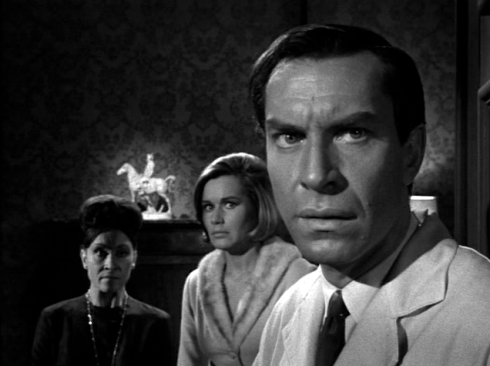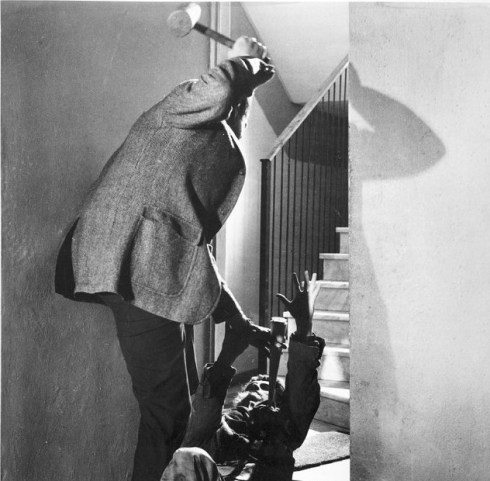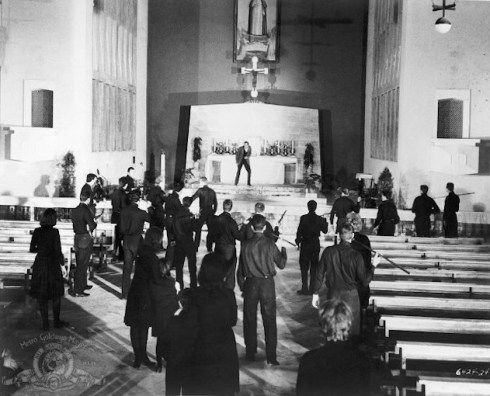Both films have that right amount of reductive 70s horror enchantment….!
CRIMINALLY INSANE 1975
Priscilla Alden is Crazy Fat Ethel…
Now let me say right here and now, that I do not advocate fat-phobic themes and story lines. I avoided watching this film for that very reason.
“She’s 250 Pounds of Maniacal Fury” -tagline
But on one particular insomnia-ridden night, I felt the urge to try and embrace a 70s horror trope for the sake of being well-versed in my classic horror knowledge. I have to say that I was truly impressed by the simplistic and claustrophobic view with which I experienced Priscilla Alden’s performance. An unstable woman is released from an institution after she is deemed ready to face society again. The film is directed fluidly by Nick ‘Philips’ Millard
The opening titles have such a purely creepy simplicity to them, it makes me think of Saul Bass doing a film school project. It sets up the moodiness and isolation that is pervasive throughout the film.
And what I took away from this very elementary vision of madness was this… This gem of a horror film is NOT about fear of fat girls, or conflating obesity with mental illness. What I got from the story was that Ethel Janowski is just a mentally ill woman, whose food represented her comfort, her freedom, and her identity. And when the interfering people in her life, like her uptight Grandma Janowski (Jane Lambert) or slutty cocaine-sniffing parasite of a sister stand between Ethel and her happiness or freedom… Watch out!!!! I won’t even say that Ethel is a likable anti-hero, she’s belligerent, self-absorbed, anti-Semitic, and homicidal!

That’s about it. The idea is that people should be allowed to do what they want even if it’s perceived to be unhealthy for them. Let them eat 6 boxes of Nilla wafers and a gallon of milk. Don’t lock the kitchen cupboard or empty out the refrigerator, don’t be the delivery boy who insists that $4.50 isn’t gonna cover it, treat them like imbecile children or a nosy neighbor.


I never saw Ethel as crazy because she was overweight. It’s everyone else in the film who identifies her illness as being connected with her being ‘fat. I see her as just another off-balanced damaged soul on that old rickety Ferris Wheel of Life., who gets triggered by the people around her to go even crazier when she feels threatened or out of control.
The mood is fabulous, I think of Don’t Look in The Basement the very stark and realistic tone of the plain environment, that still holds a sense of strange & lurking weirdness. Thanks to the cinematography by Karil Ostman and the sound by Ronald Gertz that works so well to conform to the queasy atmosphere and Ethel’s derangement.
THE CANNIBAL MAN 1973 or Week of the Killer
or (US dubbed release “The Apartment on the 13th Floor”-again misleading as all the murders take place in Marcos’ little historic house that keyholes the backdrop of modernity and the high-rise apartments of the nouveau riche.
Directed by Eloy De La Iglesia known for his interesting To Love, Perhaps to Die 1973Â with Sue Lyon, Christopher Mitchum, and Jean Sorel.
Just a word of warning there is a very disturbing scene in the beginning that takes place in the slaughterhouse. Those of you as sensitive to animal cruelty or killings like myself would advise you to skip the first awful minute and get into the wonderful jazz score by Fernando G. Morcillo that leads you out of the Charnel house and into the openness of the city.
First to clarify one thing about The Cannibal Man… the film has nothing to do with cannibalism, and it is unfortunate that such a moody psychological film should be anchored with a label that would give the wrong impression of the story. I am a fan of Spanish horror films, and I am actually adding this one to my list of favorites, having navigated around the title and sitting with the film on its own terms. A film about an alienated man, who is surrounded by a landscape of modernity taking over the quaint and a pervading sense of loneliness and futility. Marcos is a tragic figure in a very bloody play.
Vincente Parra is perfect as the virile yet detached Marcos… a fascinating character. the archetypal outsider who stumbles into a whirlpool of trouble in a single moment of fate that makes him spiral into a fog of Sisyphusian madness, filled with diss-associative savagery that lifts the film out of ordinary gore into art-house butchery.
Marcos works for the local slaughterhouse. One night while on a date looking for a taxi with his girlfriend, they find a very nasty and violent cabby who kicks them out of his cab when he gets offended by the couple kissing in the back seat. Marcos argues with him and refuses to pay for the ride. The driver actually physically punches Marcos and then assaults Paula (Emma Cohen) In a fit of rage and legitimate self-defense Marcos picks up a large rock and kills Goyo Lebrero the taxista.
Marco manifests a strange neutrality around the situation. Back at Marco’s house, Paula insists on going to the police and telling them what happened. Marco begs her to understand that the police won’t believe it was an accident. “Don’t you see Paula, if I go to the police they will never listen to someone as poor as I am…”
Marcos says that her parents will be furious that she’s been seeing him and he just can’t afford to get into trouble. But… she refuses to listen to him. She breaks it off with him, telling him that she won’t be made a fool of, and marriage shouldn’t be based on lies. You can see Marco begin to uncoil at that moment. “So I can go to the police… or I can go to hell right!”

Marco kisses her as his hands crush the life from her throat, we see her struggle, a close-up of her green eyes, and Marcos with a somnambulist sense of self-preservation, a killing machine that must operate to keep himself one step away from the horrible incident with the cab driver and the insanity that has been let out of his head.
What makes the film so eerie and realistic is this nightmarish cycle, this spiraling out-of-control pace where Marco must continue to remove all obstacles that threaten his sense of autonomy as an outlier in the world. Even from the beginning, we get the sense that he is not as interested in marrying Paula as she is in marrying him.
Once his brother comes to the house, his brother’s fiancée looking for him, and her inquisitive father shows up, oh and the nice local waitress Rosa (Vicky Lagos) who has had her eyes on Marcos, he must continue to kill each one in order to protect his secret.

He begins posing the bodies in his sparse bedroom, using as much room freshener as he can, before the smell of death becomes too obvious. Yet on the outside, he acts as if nothing has happened, or that there are several rotting bodies in his bedroom. He then takes them to the slaughterhouse piece by piece in his duffel bag.
The ordinary look of Marcos’ simplistic home, the bachelor setting, his wall of tools, no frills, no style or I should say money for such privileges is perhaps necessary for the very trappings of an underclass worker in the early 1970s. There is an overt sense to the film about classist friction …


Of particular interest is the relationship that develops between Marcos and the handsome bourgeois Néstor (Eusebio Poncela )who lives on the 13th floor of the high rise behind Marcos’s humble little cottage. Néstor’s interactions with Marcos allow him to be free of the fear and frenzy he is submerged in. There is an element of homosexual attraction for both men. It’s a poignant chemistry and adds a layer of realism in the midst of the bloody fugue of Marcos’ environment and identity. At one point Marco speaks of his bad memories… Néstor suggests that he should perhaps “bury them’ already. It leaves us wondering if the tranquil authoritative and voyeuristic fellow knows what the mysterious Marcos has been doing but is a silent admirer out of love.
Néstor perhaps speaks the most telling idea of the story when he tells Marco who warns him about the dangerous wild dogs that roam the area while walking his Boxer who is in heat… “There’s no danger, a well-fed dog is always stronger than the hungry ones”
This has been your everlovin’ MonsterGirl sayin’ in any case, never run out of air freshener!
































































































































































































































































































































































